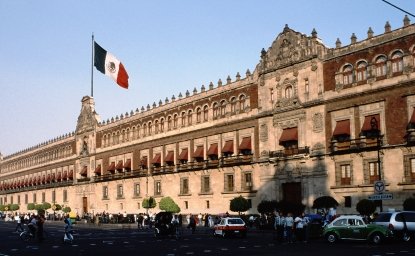Last Sunday’s general elections in Mexico were historical for many reasons. First, MORENA with its founder-candidate, Andres Manuel López Obrador (AMLO), won the Presidential election, giving Mexico its first left-leaning government in democratic history. Second, the thirty percentage points that AMLO had over the second place candidate (Ricardo Anaya) is the largest victory margin since the 1982 Presidential election where Miguel de la Madrid won by 55 points. Third, this election could be the first step towards a new party system where the once all-mighty PRI loses relevance, PAN is deeply fractured, PRD loses its left-wing monopoly, and MORENA is the primary political force in Congress.
This election will be remembered as the one where the PRI lost what was left of that all-mighty party. With the PREP officially closed, the PRI won around 16% of votes for President and 16% of the Senate and lower House. Adding to this overwhelming defeat at the federal level is its poor performance at the local level. Of the nine states where the governor position was up for grabs, the PRI did not win any of them and will be in third place or worse in all (getting no more than 20% of votes in each of them) except Yucatán, where they will finish second. With the final PREP data, the PRI did not win a state, only won one electoral district, and 8.9% of municipios in the country.
With this historic defeat at the federal and state level, after 90 years as Mexico’s dominant party, will the PRI be able to bounce back and recapture their all-mighty position? An insight into this topic was provided by Joy Langston during the “Mexico Election 2018: A Historic Vote Across the Nation” at the Wilson Center: Without support from state and local level victories, it will be hard for the PRI to build a winning campaign for the next electoral process. The way the PRI lost the election this past Sunday limits the party’s access to state and local support (they now govern fewer and smaller states than in 2000), and they will not be able to move their political agenda in Congress alone. With these results, the PRI is starting an uphill path towards redemption. It will be interesting to see how the party restructures their ideals and strategies to compensate for their poor performance.
The other big loser of Sunday’s elections is the PAN-PRD coalition, the “Frente.” The non-ideological coalition between these two parties raised more concerns than answers for the Mexican voter. Despite positioning themselves as the secondary political force after receiving 22% of the Presidential vote, both parties are left with deep structural problems. PAN and PRD together could not get more votes than the 2012 third place PAN (Josefina Vazquez Mota had almost 26%). When looking at other races, the picture does not get better for PAN, and it is very troubling for PRD. PAN will get around 18% for the Senate and the lower House while PRD has only 5% in the Senate and the lower House. With this result, the PRD not only loses the left-wing leadership but also steps down to the national fourth place, losing its place as one of Mexico’s most important parties. In state elections, the results look a little better; the coalition was able to achieve some key victories in Guanajuato and Puebla, and PAN was also able to win Yucatán without the coalition.
The PAN-PRD coalition is typical for Mexican politics, but is not an alliance typically seen in the rest of the world, as it has a right-wing party join forces with a left-wing party. This coalition is one made of convenience – as an anti-incumbent strategy – rather than one of similar ideologies. In my own research, I explore the consequences on voters’ behavior of two such ideologically different parties coming together. First, voters like to have easy access to information and ideology is one of the most important cues. With two non-contiguous parties coming together, voters are unable to disentangle the coalition position in the spectrum easily. Second, voter behavior in Mexico tends to be economic or clientelistic; they look for rents or benefits that parties can assign them. The coalition sits in a suboptimal position where resources have to be assigned to very different policy options and voters don’t see a direct way of benefiting from them. Third, the anti-incumbent strategy used by the coalition at the state-level elections was the wrong one at the federal level, given the opponent. Similar coalitions in the past have targeted the PRI as the incumbent force, and this coalition strategy was no different, but the political landscape had dramatically changed this time. AMLO is not only a non-incumbent, but a better known anti-incumbency force than the PAN-PRD coalition.
The great winner from this electoral process is undoubtedly MORENA. They not only won the presidency, but they did so in a dominant way, winning 53% of the vote. This landslide victory is complemented with an almost certain majority in Congress. With data from the PREP, they have 37% of the Senate and the lower House. These numbers will increase with their allies guaranteeing a majority in Congress. As if such success at the federal level was not enough, MORENA and their coalition partners have been able to win 5 of the 9 governor elections throughout the country (including Mexico City).
After the dominant victory, everything seems to be going MORENA’s way, but it is relevant to ask if this success can be sustained or if this party will deflate once the leader, Lopez Obrador, steps away from the political scene. MORENA is a party that was created by AMLO in order to postulate himself as a presidential candidate once PRD moved away from him. As mentioned by Eric Magar at the Wilson Center, MORENA candidates at the local and state level relied heavily on AMLO’s figure. With this mechanism, the party has been able to expand the success to other instances where the leader was not directly involved. But, can MORENA rely on this strategy forever? The next six years will be key for the survival of this party. Either AMLO’s presidency will be a success or the support they got from “independent” voters this year will switch to whatever option seems better when the next election comes around. If MORENA is not capable of maintaining and expanding their base, their incumbency and relevance as a political actor will end soon after.
MORENA’s victory on Sunday is not only changing Mexico’s government but is also changing the Mexican party system. On the right side of the spectrum, we have a very fragmented PAN that has been divided in half because of their coalition with the PRD and the imposition of Ricardo Anaya as the presidential candidate. The once strong opposition party has a lot of work to do to recover those voters who decided to support someone else. PAN must return to the values under which it was created to appeal to its base and be a strong contender again. The PRI needs a complete restructuring of policies and values. The once long-standing incumbent now has to fight the opposition and without much local or state level support. It will be interesting to see how PRI evolves into a new party, if they do at all. Moving to the left, we might have seen the last election with the PRD as a relevant party. The massive defeat they suffered might be the last blow they needed before disappearing. The coalition with PAN prevented them from stealing votes from MORENA and took them far from the left side of the spectrum. Last but clearly not least, MORENA is now the left-wing champion. It took most of PRD’s votes and bastions and was able to position itself as the only strong left-wing option, at least for the next six years. It is still to be seen if they can hold the position for more than one or two electoral cycles, particularly without the personal force of AMLO.
Miguel Garza is a research assistant for the Wilson Center's Mexico Institute and a PhD candidate at The Ohio State University.
Author
PhD Candidate, The Ohio State University

Mexico Institute
The Mexico Institute seeks to improve understanding, communication, and cooperation between Mexico and the United States by promoting original research, encouraging public discussion, and proposing policy options for enhancing the bilateral relationship. A binational Advisory Board, chaired by Luis Téllez and Earl Anthony Wayne, oversees the work of the Mexico Institute. Read more

Explore More
Browse Insights & Analysis
Mexico's 2018 Elections: A Historic Vote



